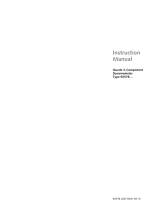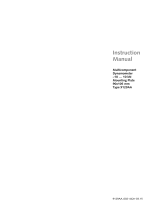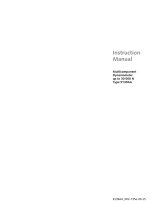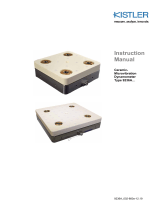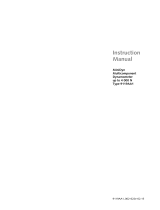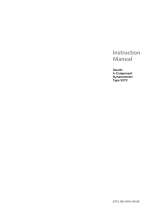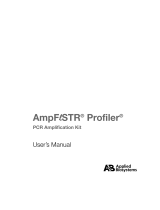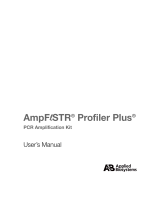Page is loading ...

Instruction
Manual
Multicomponent
Force Plate
Type 9253B…
9253B_002-050e-12.14

Instruction
Manual
Multicomponent Force
Plate
Type 9253B…
9253B_002-050e-12.14


Foreword
Page 1 9253B_002-050e-12.14
Foreword
We thank you for choosing a Kistler quality product
distinguished by technical innovation, precision and long
life.
Information in this document is subject to change without
notice. Kistler reserves the right to change or improve its
products and make changes in the content without
obligation to notify any person or organization of such
changes or improvements.
©2001 … 2014 Kistler Group. All rights reserved. Except as
expressly provided herein, no part of this manual may be
reproduced for any purpose without the express prior
written consent of Kistler Group.
Kistler Group
Eulachstrasse 22
8408 Winterthur
Switzerland
Tel. +41 52 224 11 11
Fax +41 52 224 14 14
www.kistler.com

Multicomponent Force Plate, Type 9253B…
Page 2 9253B_002-050e-12.14
Content
1. Introduction ................................................................................................................................... 4
2. Important Information .................................................................................................................... 5
2.1 For Your Safety .................................................................................................................... 5
2.2 How to Treat the Instrument ................................................................................................ 6
2.3 Tips for Using the Instruction Manual .................................................................................. 7
2.4 What Happens After Modifications? .................................................................................... 7
3. General Description of the Instrument ........................................................................................... 8
3.1 What does a Multicomponent Force Plate do? ..................................................................... 8
3.2 Functional Principle .............................................................................................................. 9
3.3 Design of the Multicomponent Force Plate ........................................................................ 10
4. Assembly, Installation and Putting Into Operation ...................................................................... 11
4.1 Important Remarks ............................................................................................................. 11
4.2 Installing the Force Plate .................................................................................................... 11
4.3 Dynamometer Positioning .................................................................................................. 12
4.4 Basic Circuitry and Cabling of the Measuring System ......................................................... 13
4.4.1 Force Measuring with 3 Components (Fx, Fy, Fz) .................................................... 14
4.4.2 3-Component Force Measurement ........................................................................ 15
4.4.3 Force and Moment Measurement with 6 Components (Fx, Fy, Fz, Mx, My, Mz) ....... 16
5. Operation ..................................................................................................................................... 18
5.1 Range Selection .................................................................................................................. 18
5.2 Measuring Small Force Changes ......................................................................................... 18
5.3 Usable Frequency Range .................................................................................................... 20
5.4 Temperature Influences ...................................................................................................... 24
5.5 Polarity of the Measuring Signal ......................................................................................... 24
6. Maintenance ................................................................................................................................ 25
6.1 Recalibrating the Instrument .............................................................................................. 25
6.2 Maintenance Tasks ............................................................................................................. 26
7. Troubleshooting ........................................................................................................................... 27
7.1 Diagnosis and Rectification of Faults .................................................................................. 27
7.2 Defective Multicomponent Force Plate ............................................................................... 28
8. Technical Data ............................................................................................................................. 29
8.1 3-Component-Dynamometer Type 9253B… ..................................................................... 29
8.2 Accessories ......................................................................................................................... 32

Content
9253B_002-050e-12.14 Page 3
9. Annex ........................................................................................................................................... 33
9.1 Glossary .............................................................................................................................. 33
9.2 Measurement Uncertainty .................................................................................................. 37
9.3 Linearity .............................................................................................................................. 38
9.4 Frequency Range ................................................................................................................ 41
9.5 Influence of Temperature .................................................................................................... 43
Total pages 44

Multicomponent Force Plate, Type 9253B…
Page 4 9253B_002-050e-12.14
1. Introduction
Please take the time to thoroughly read this instruction
manual. It will help you with the installation, maintenance,
and use of this product.
To the extent permitted by law Kistler does not accept any
liability if this instruction manual is not followed or
products other than those listed under Accessories are
used.
Kistler offers a wide range of products for use in measuring
technology:
Piezoelectric sensors for measuring force, torque, strain,
pressure, acceleration, shock, vibration and acoustic-
emission
Strain gage sensor systems for measuring force and
moment
Piezoresistive pressure sensors and transmitters
Signal conditioners, indicators and calibrators
Electronic control and monitoring systems as well as
software for specific measurement applications
Data transmission modules (telemetry)
Kistler also develops and produces measuring solutions for
the application fields engines, vehicles, manufacturing,
plastics and biomechanics sectors.
Our product and application brochures will provide you
with an overview of our product range. Detailed data
sheets are available for almost all products.
If you need additional help beyond what can be found
either on-line or in this manual, please contact Kistler's
extensive support organization.

Important Information
9253B_002-050e-12.14 Page 5
2. Important Information
2.1 For Your Safety
This instrument has been tested thoroughly and it left
the works in a perfectly safe condition. To maintain this
condition and assure safe operation, the user must
observe the directives and warnings contained in these
instructions.
The force plate must be installed, operated and
maintained only by persons who are familiar with it and
adequately qualified for their particular tasks.
When it must be assumed that safe operation is no
longer possible, the instrument must be taken out of
operation and secured against unintentional use.
It must be assumed that safe operation is no longer
possible if:
the instrument is visibly damaged,
it no longer functions,
it has been in lengthy storage under adverse
conditions,
it has received rough treatment during transport
Important!
Fix the force plate on the mounting surface according
to the instructions. See section 4 "Assembly,
Installation and Putting Into Operation" for details.
Important!
Fix all parts mounted on the top plate of the force plate
according to the forces expected!
Warning!
Danger of injuring your hands! Move the force plate
only by using the eyebolts supplied.

Multicomponent Force Plate, Type 9253B…
Page 6 9253B_002-050e-12.14
2.2 How to Treat the Instrument
The force plate may be used only under specified
environmental and operating conditions.
The insulation resistance is crucially important with
piezoelectric measurements. It must be around 1014 Ω
(but at least 1013 Ω).
To obtain this resistance, all plug and socket
connections must be kept meticulously clean and dry.
The insulation resistance can be measured with the
insulation tester Type 5493.
Protect the signal output against dirt and do not touch
it with your fingers. When the connection is not being
used, cover it with the cap provided.
The connecting cable (from the force plate to the
charge amplifier) is highly insulating. Use the proper
cable only.
Do not remove the connecting cable from the force
plate.
When not in use keep the dynamometer in the original
packaging to protect it.
When performing long-time measurements, make sure
that the temperature of the force plate remains as
constant as possible.

Important Information
9253B_002-050e-12.14 Page 7
2.3 Tips for Using the Instruction Manual
We recommend reading the entire Instruction Manual as a
matter of principle. If you're in a hurry, however, and
you've already gathered experience with Kistler force
plates you can confine your reading to the information that
you really need.
We have endeavored to arrange these instructions so that
you can find the information you need without difficulty.
Please keep this Instruction Manual in a safe place where it
can be consulted any time.
If the instructions get lost, just turn to your Kistler customer
service station and they will be replaced without delay.
All information and directives in this Instruction manual
may be modified at any time without notification.
2.4 What Happens After Modifications?
Modifications to instruments result in alterations of the
Instruction Manual as a rule. In such cases, enquire at your
Kistler customer service station about the possibilities of
updating your documentation.

Multicomponent Force Plate, Type 9253B…
Page 8 9253B_002-050e-12.14
3. General Description of the Instrument
3.1 What does a Multicomponent Force Plate do?
The multicomponent force plate provides dynamic and
quasi-static measurement of the 3 orthogonal components
of a force (Fx, Fy, Fz) acting from any direction onto the top
plate.
With the aid of optional evaluation devices the 3 moments
Mx, My and Mz can be measured as well.
The force plate has high rigidity and hence high natural
frequency. The high resolution enables very small dynamic
changes to be measured in large forces.
The force plate measures the active force regardless of its
application point. Both the average value of the force and
the dynamic force increase may be measured. The usable
frequency range depends mainly on the resonance
frequency of the entire measuring rig (top plate,
foundation).
Fig. 1: Type 9253B…
Most important applications fort he multicomponent force
plate are:
Cutting force measurements in milling, grinding and
other machining operations
Ergonomic measurements
Measurements on stamping machines and presses
Measurements of impact forces
Measurements of wheel forces
Measurements of supporting forces

General Description of the Instrument
9253B_002-050e-12.14 Page 9
3.2 Functional Principle
The force to be measured is introduced via a top plate and
distributed between four 3-component force sensors
arranged in a force measuring element.
Each of the sensors has three pairs of quartz plates, one
sensitive to pressure in the z direction and the other two to
shear in the x and y directions respectively. The
measurement is virtually without displacement.
In these four force sensors the force introduced is broken
down into three components.
Fig. 2: 3-Component force sensor
For the force measurement in 3 components the individual
signals are led together in the connecting cable.
For force and moment measuring with 6 components, all 8
individual signals are led via the connecting cable straight
to the charge amplifiers.
Depending on the direction of the force, positive or
negative charges occur at the connections. Negative
charges give positive voltages at the output of the charge
amplifier, and vice versa.

Multicomponent Force Plate, Type 9253B…
Page 10 9253B_002-050e-12.14
3.3 Design of the Multicomponent Force Plate
The multicomponent force plate consists of four force
measuring elements each comprising one 3-component
force sensor under preload.
The integrated 3-wire cable runs in a protective tube. The
four cables are connected together in a summing box.
The four force sensors are mounted ground-insulated.
Ground loop problems are largely eliminated in
consequence.
The multicomponent force plate is rustproof and protected
against ingress of splash water and coolant.
Together with the connecting cable Type 1687B5 or
1677A5 the multicomponent force plate meets the
requirements of degree protection IP67.
1 Force measuring element
2 Integrated cable
3 Summing box
4 Connector
5 Top plate customer side
6 Lateral cover

Assembly, Installation and Putting Into Operation
9253B_002-050e-12.14 Page 11
4. Assembly, Installation and Putting Into Operation
4.1 Important Remarks
The multicomponent force plate is a precision instrument,
but its inherent accuracy can be exploited and retained
only if it is treated with care. The following rules should
therefore be noted:
Never drop the force plate or expose it to heavy
impacts! The maximum force of a shock of this kind
could exceed the measuring range of the instrument
and cause permanent deformations.
Never use a hammer to position the workpieces, as
such blows might also cause deformation!
On the following pages you will find directions for
installing the force plate on the machine table and about
the base circuitry and cabling of the measuring equipment.
4.2 Installing the Force Plate
To install the force plate correctly please observe the
following points:
The force plate must be installed only by persons
familiar with the device and sufficiently qualified for this
work.
Connect the connecting cable first to the force plate.
Both connecting sides (plate and cable) must be cleaned
with cleaning and insulation spray Type 1003. The O-
ring is fitted to seal the connection. The contact
surfaces for the O-ring must be clean. Insert the O-ring
and bolt the flange of the cable to the summing box
with the two bolts and tighten until it fits.
Before installing the force plate on a machine tool or a
test rig check the flatness of the installation surface.
Uneven contact surfaces cause internal distortions
which expose the individual force sensor to additional
strong axial load an can increase crosstalk.
The bearing surfaces of the load sensing device (bases)
are finely machined. The device must therefore be
installed only on surfaces which are ground or finished
to comparable standard. Clean the bearing surfaces
thoroughly before assembling.
The force plate is aligned on the machine table with the
help of one of the longitudinal sides of the plate.
Make sure that the force plate rests absolutely flat.
Even the smallest air gap will cause undesirable

Multicomponent Force Plate, Type 9253B…
Page 12 9253B_002-050e-12.14
elasticity and reduce the resonant frequency of the
measuring rig. All mountings must therefore be
considered from the vibration aspect also.
Check whether the force plate rocks by alternately
pressing on diagonally opposite corners of the force
plate. Any rocking is clearly audible.
If there is rocking, lift the force plate off and insert one
of the shims supplied together with the force plate. If
the thinnest shim is too thick, a piece of aluminium foil
may prove suitable. Insert shims at one corner only.
Whenever possible, the connecting cable should be left
connected permanently to the force plate.
Slightly grease the four supplied hexagon socket head
cap screws M12x30 and slide them into the four bores
of the force plate.
Before tightening the screws check wether there is in
fact no rocking over the diagonals.
Important:
Before tightening the fastening screws consideration
should be given that there are no extreme temperature
differences between the force plate and mounting
surface. Otherwise there is the danger of high internal
stresses between force plate and mounting surface when
the temperatures adjust.
Tighten the four hexagon socket head cap screws M12
with a tightening torque of 90 N·m. (A hexagon
extension bar is supplied together with the force plate.)
Under slight pressure with the palm and simultaneous
twisting insert the four tops into the top plate.
4.3 Dynamometer Positioning
The dynamometer and the cables must be posi-tioned
so that coolants can drain completely. This stops
aggressive bacteria forming in old coolant, which could
then damage the dynamometer and the cables.
Depressions and creases should therefore be avoided
Install the connecting cable so that it can neither shear
off nor be pulled out when working

Assembly, Installation and Putting Into Operation
9253B_002-050e-12.14 Page 13
4.4 Basic Circuitry and Cabling of the Measuring System
The electrical charges (pC) supplied by the force plate are
converted by charge amplifiers into proportional voltages
which can be displayed, recorded and processed with the
usual instruments.
Please note the followin
g
as re
g
ards connectin
g
the
measuring system:
The connecting cables from the force plate to the
charge amplifier must have a high level of insulation
and a low level of frictional electricity. Only the
recommended connecting cables should therefore
be used.
Ordinary cables can be used for the connection
between the charge amplifiers and the display and
evaluation instruments.
All electrical connections must be made cleanly and
with care. The connection cover caps should not be
removed until immediately before connecting the
cable.
Please follow the instructions for cabling specific
configurations in the two following sections.

Multicomponent Force Plate, Type 9253B…
Page 14 9253B_002-050e-12.14
4.4.1 Force Measuring with 3 Components (Fx, Fy, Fz)
The illustration below shows the elements needed to
connect the force plate with a 3-channel charge amplifier
(such as Tyep 5070Ax01xx). It is a ground-insulated
measuring chain with 3-wire cable.
Fig. 3: Force measurement with 3 components (Fx, Fy, Fz)
The connecting cable Type 1687B5 and the extension
cable Type 1688B5 are wired as follows:
Input Output Input Output
Pin No. Out
p
ut si
g
nal
1 Ground (GND)
2X
3
–
4Y
5
–
6Z
7
–
8
–
9
–
Fig. 4: Allocation connecting cable Fig. 5: Allocation
Type 1687B5/1689B8 extension cable
Type 1688B5

Assembly, Installation and Putting Into Operation
9253B_002-050e-12.14 Page 15
4.4.2 3-Component Force Measurement
The form of dynamometer construction ensures the acting
forces do not exert any moments on the individual force
link. The force link can therefore be loaded (without any
moments) up to the maximum defined measuring range.
However, a force whose line of action does not pass
through the zero of the dynamometer produces a moment
relative to this zero. These moments cause the sensors to
be subjected to an additional load in one or more
directions.
For 3-component force measurement with a dynamometer
consisting of four 3-component force links, the output
signals (Fx, Fy and Fz in each case) of these links are
summed. However, irrespective of the force application
point, the sum of the four force links always indicates the
correct value.
A 3-component dynamometer measures the magnitude
and direction of the three components of the forces acting
on a dynamometer, but not their spatial location.
Depending on the position of the force application point,
the load is either distributed between all four force links or
an individual force link can take most of it. If the force acts
well outside the force plate, lever action can cause an
individual force link to be subjected to a multiple of the
force to be measured. For such applications the load on an
individual force link must be accurately calculated.
For information about the maximum space of the force
application point please see chapter 8.1.
If there is a possibility of the acting loads damaging the
dynamometer, please contact your Kistler Customer Service
Center, where an analysis can be carried out for your load
case.

Multicomponent Force Plate, Type 9253B…
Page 16 9253B_002-050e-12.14
4.4.3 Force and Moment Measurement with 6 Components (Fx, Fy, Fz, Mx, My, Mz)
The illustration below shows the elements needed to
connect the force plate with an 8-channel charge amplifier
(such as Type 5070Ax11xx). It is a ground-insulated
measuring chain with 8-wire cable.
Fig. 6: Force and moment measurement with 6 com-
ponents (Fx, Fy, Fz, Mx, My, Mz)
The connecting cable Type 1677A5 and the extension
cable Type 1678A5 are wired as follows:
Input Output
Pin No. Out
p
ut si
g
nal
1 Ground (GND)
2X1 + 2
3X3 + 4
4Y1 + 4
5Y2 + 3
6Z1
7Z2
8Z3
9Z4
Fig. 7: Allocation connecting cable Type 1677A5/1679A5
and extension cable Type 1678A5

Assembly, Installation and Putting Into Operation
9253B_002-050e-12.14 Page 17
The individual forces and torques can be calculated as
follows:
Fx = Fx1+2 + Fx3+4
Fy = Fy1+4 + Fy2+3
Fz = Fz1 + Fz2 + Fz3 + Fz4
Mx = b · (Fz1 + Fz2 – Fz3 – Fz4) · kMx
My = a · (–Fz1 + Fz2 + Fz3 – Fz4) · kMy
Mz = b · (–Fx1+2 + Fx3+4) + a · (Fy1+4 – Fy2+3) · kMz
a and b are the dynamometer constants in the above
formulas, while kM represent the correction factors.
The values for Type 9253B… are:
a = 120 mm, b = 200 mm
Deviations occur when measuring the torques because a
dynamometer is not infinitely stiff. These deviations are
corrected by the correction factors kMx, kMy and kMz.
They are normally not provided but must rather be
determined through a special calibration. The design of this
special calibration must be as close as possible to the real
measurement design to prevent measurement inaccuracies.
If the correction factors are available, then they must be
included in the calculation. Depending on the
characteristics, the charge amplifiers Type 5070A and
5080A offer the option to set the correction factors
directly. Factor 1 is already set for the correction factors
kMx, kMy and kMz by default.
Depending on the analysis of the measuring results, the
distance between the cover plate surface and the sensor
center is the deciding factor. This distance is called az0.
The value for Type 9253B… is: az0 = 54,5 mm
/

